Cabo de Gata Beaches of Almeria
An introduction of the beaches of Almeria ![]()
- accessibility guide
- naturist beaches
- map of the coastline
Almeria - Andalucia - Southern Spain
The coastline of the Cabo de Gata Natural Park, an area of special protection which extends into the sea as a marine reserve, is one of the main attractions of this exceptional area.
The volcanic history of the land, along with the effects of nature, have created a shoreline of dramatic  cliffs with isolated coves and bays hiding away some of Andalucias most amazing beaches, offering unspoilt locations in which to relax and enjoy the quality of the water and the abundance of sea life.
cliffs with isolated coves and bays hiding away some of Andalucias most amazing beaches, offering unspoilt locations in which to relax and enjoy the quality of the water and the abundance of sea life.
The Beaches of Cabo de Gata:
- Cabo de Gata beach guide and map
- Southern coastline - San Miguel de Cabo de Gata
- Cabo de Gata Peninsula - Playa de Coralette - Cala Raja - Las Sirenas reef
- San Jose - Playas de los Genoveses and Playa de Monsul
- Escullos to Rodalquilar - Isleta del Moro - Playa del Arco - Playa Peñon Blanco - Playa Playazo
- Las Negras to Agua Amarga - Cala de San Pedro - Cala del Plomo - Cala de Enmedio
- Playa de los Muertos
Inland
Besides the beaches and stunning shoreline, the Cabo de Gata natural park provides a varied landscape for outdoor activities and a cultural location with many historical places of interest. The inland expanse, a semi-desert area, incorporates dry riverbeds and ravines, arid plains, mountains and valleys. 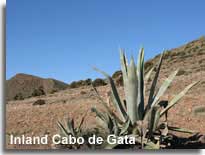 The region is home to much flora and fauna, in particular, the countless bird species which are attracted to the coastal lagoons. The fishing villages of Cabo de Gata now cater to tourism and offer the perfect holiday destination and base to explore the natural park.
The region is home to much flora and fauna, in particular, the countless bird species which are attracted to the coastal lagoons. The fishing villages of Cabo de Gata now cater to tourism and offer the perfect holiday destination and base to explore the natural park.
The fishing villages are detailed in the Cabo de Gata page which offers further information on the natural park including walking trails, bird watching, horse riding, and the local history of the region...
Choose Cabo de Gata for the best beaches in Spain
Natural hideaways in stunning surroundings...
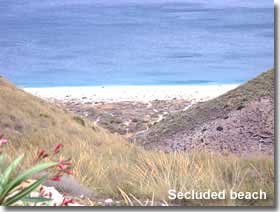
Cabo de Gata Beaches
The allure of the beaches of the Cabo de Gata, beside their unaffected beauty and transparent clean waters, are their secluded locations and natural surroundings. It is important to remember that all this comes with a price, only a small one in comparison, but there are no services at these beaches and coves, so it is very important to take supplies, including plenty of water.
Many of the Cabo de Gata beaches are naturist beaches and the choice to swimwear is optional.
The exception to both of these rules are the resort beaches of the fishing villages. These traditional villages provide a good selection of cafes, bars, restaurants and other services for the visitor.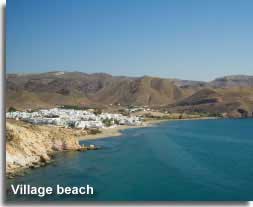
Cabo de Gata beaches...
surely some of the best in Spain!
Take a look and see what you think...
In this page I would like to share photos and information of some of the best beaches within the Cabo de Gata Natural park, many of which I have visited, starting at the most south western point, and continuing around the headland heading northwards on the eastern coastline.
Having now visited almost every beach and cove within the whole of the province of Almeria, such an arduous task! there are still some of the more hard to reach spots within the park that I have yet to experience, it is my intention to rectify this as soon as I get the chance, and I will update this page with the details as and when each remaining destination is fulfilled.
Map of the Cabo de Gata Beaches and Coves

Cabo de Gata beach guide
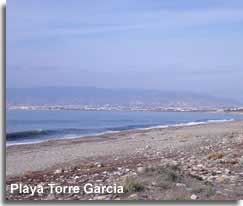
The beaches of the southern coastline
The beaches along the southern coastline are separated into four distinct beach areas by dry river beds, together they run for approximately fourteen kilometres from Retamar to the lighthouse on Cabo de Gata cape, the southern most tip of the natural park.
Playa de Torre Garcia
This rural beach, often found to be deserted, is made up of sand and pebbles, access is signposted from the ALP-202, on the stretch between Retamar and the Almoladeras visitors centre, via a track road which leads to the beach and parking zone. The area is more popular for the El Pocico - Las Marinas signposted walking trail which includes the Torre Garcia watchtower, used for spotting enemy pirate ships in days of old, and the ancient Roman salt factory, both of which are situated next to the beach. 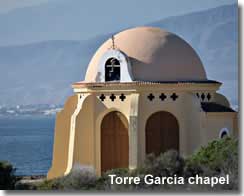
Walking trails of the Cabo de Gata ![]()
A further historical monument, and the one that gives its name to the beach, is the Ermita Torre Garcia chapel, built as a shrine to the Virgen del Mar, the virgin of the sea, it is said that its construction was inspired after a wooden carving bearing the image of the Virgen del Mar was found on the beach, probably washed in from a shipwreck.
Playa de las Amoladeras and Playa del Charcon
Both these rural beaches, of fine sand and pebbles, can be reached on foot from either Playa de Torre Garcia or the beach of San Miguel. 
Playa San Miguel de Cabo de Gata
This is the largest, prettiest and most popular beach on the southern coastline which starts by the fishing village of the same name. The long sandy beach, well known for its colourful fishing boats and clear blue waters, never really gets crowded, the busiest area is from the town to the old Civil Guardia tower where there is a chiringuito beach bar providing sun beds, parasols and refreshments on the beach, with parking available close by.
Running parallel to the beach and within view of the ALP-822 coast road is Las Salinas de Cabo de Gata, a saltwater lake that provides a natural year round stop off point for migrating flamingos, in July and August 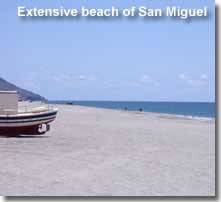 they can be seen in large numbers and special observation points allow for close up viewing. Beside the graceful flamingos Las Salinas de Cabo de Gata provides a special destination for bird watching in Almeria, there are many more migrating birds and resident species to be spotted.
they can be seen in large numbers and special observation points allow for close up viewing. Beside the graceful flamingos Las Salinas de Cabo de Gata provides a special destination for bird watching in Almeria, there are many more migrating birds and resident species to be spotted.
Bird watching in Las Salinas de Cabo de Gata ![]()
The beach and coast road extends to the salt mining village of Almadraba de Montelevela, which has a small promenade and a few cafes, continuing then to the La Fabriquilla area, where the beach narrows to its end and the coast road ascends the Sierra de Cabo de Gata to the lighthouse.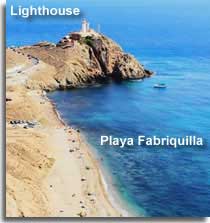
The Cabo de Gata lighthouse & peninsula
The lighthouse sits on the rocky headland of the Cabo de Gata at the southern most point of the Natural Park. At this point the coast road comes to an end and the beaches on the eastern coastline of the natural park, by vehicle, can only be reached by using an inland route. It is however possible to access the eastern shores, beaches and village of San Jose on foot, starting from Cala Raja and following the Vela Blanca signposted walking route. 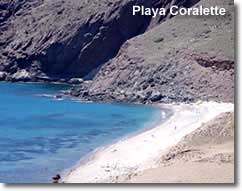
It is worth noting that a good head for heights is required along the cliff road to the lighthouse, at its highest point the road does narrow to the width of one car and care must be taken.
Walking trails of the Cabo de Gata ![]()
Playa del Coralette and Cala Raja
Access for both beach areas is via a left hand turn at the signpost for Playa del Coralette before reaching the lighthouse.
Playa del Coralette
A beautiful sandy beach in an outstanding out of the way location which is accessible by vehicle, many wouldn't even know of its existence, the waters are clear blue and there is parking available close by.
These photos 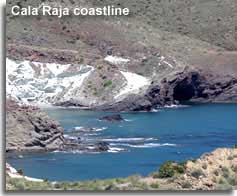 were taken on an weekend afternoon in June, illustrating the peacefulness of Playa Coralette, at the most I would say there were only eight or nine people on the beach, and there were not that many more on the beach at Cala Raja.
were taken on an weekend afternoon in June, illustrating the peacefulness of Playa Coralette, at the most I would say there were only eight or nine people on the beach, and there were not that many more on the beach at Cala Raja.
Cala Raja
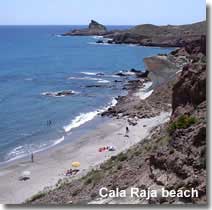 This astonishing cove is home to the white rocks of Vela Blanca, the white sail, aptly named after the shape and colour of the volcanic formations. It is overlooked by the Torre de Vigia de Vela Blanca watchtower which sits on top of the coastal cliffs. The track road that leads to the beach offers some sensational views of the rocky shoreline with its caves and unusual rock formations. A relatively small beach,
This astonishing cove is home to the white rocks of Vela Blanca, the white sail, aptly named after the shape and colour of the volcanic formations. It is overlooked by the Torre de Vigia de Vela Blanca watchtower which sits on top of the coastal cliffs. The track road that leads to the beach offers some sensational views of the rocky shoreline with its caves and unusual rock formations. A relatively small beach, 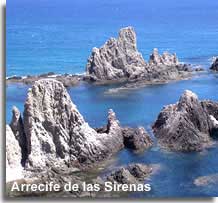 it is the setting that is the main draw of this sandy spot, it is truly spectacular, and, as an added bonus, the clear blue waters make for ideal snorkelling conditions.
it is the setting that is the main draw of this sandy spot, it is truly spectacular, and, as an added bonus, the clear blue waters make for ideal snorkelling conditions.
Lighthouse and Arrecife de las Sirenas
While there is no beach at the pinnacle of the cape, the volcanic rock formations of Sirenas Reef, Arrecife de las Sirenas, make a very special destination for kayak, canoe and snorkelling trips. Overlooked by the lighthouse and the Mirador de la Sirenas, the unique seascape makes a striking sight from this elevated vantage place which is a popular stopping point for many a tourist.
San Jose and the hidden coves

The coastal village of San Jose, not without its own beaches, also offers access to many hidden bays that are situated between the village and the Cabo de Gata headland in the south. These rural beaches are signposted from the village centre by following the sign for Routa del Cine - San Jose - Monsul, namely the cinema route from San Jose to Monsul, so called as the distinct settings of Playa de los Genoveses and Playa de Monsul have been used as location backdrops by cinema  directors and image specialists.
directors and image specialists.
Playa de San Jose
San Jose is the main resort of the Cabo de Gata, offering plenty of accommodation and facilities in a friendly low key, low rise, white fishing village. Situated in a sheltered bay, with a harbour at the northern most point, the beach is sandy and the transparent waters are shallow, making a perfect destination for families. Scuba diving courses and diving itineraries are available from the water sport centres.
Water sports and water sports centres Cabo de Gata ![]()
The Hidden Coves
Playa de los Genoveses and Playa de Monsul

Considering their remote location and lack of services, these beaches are two of the most well known in the natural park and can be reached via a track road, by car, cycle or on foot. It is worth noting that in the summer months access to the road is limited to prevent mass tourism and it is best to arrive early, even as early as 9am, to ensure entry by vehicle.
San Jose to Playa de los Genoveses is approximately three kilometres, and roughly half an hours walk.
San Jose to Playa de Monsul is approximately five kilometres, and roughly one hours walk.
The coves and beaches between Genoveses and Monsul, namely Cala Amarilla, Cala Chica, and Playa del Barronal can only be reached on foot, the rewards for this effort are said to be quite something.
Genoveses beach
A wide sheltered sandy beach with shallow clear waters surrounded by dunes and vegetation 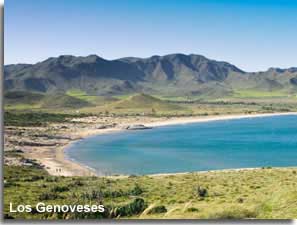 and situated between two accessible hilltops, the Cerro Ave Maria and Morron de los Genoveses, both offering gorgeous views of the coastline. The location was used as a backdrop for scenes in the well known Lawrence of Arabia movie staring Peter O'Toole, Alec Guinness, and Anthony Quinn and directed by David Lean. The landscapes can be best appraised from the Los Genoveses signposted walking route.
and situated between two accessible hilltops, the Cerro Ave Maria and Morron de los Genoveses, both offering gorgeous views of the coastline. The location was used as a backdrop for scenes in the well known Lawrence of Arabia movie staring Peter O'Toole, Alec Guinness, and Anthony Quinn and directed by David Lean. The landscapes can be best appraised from the Los Genoveses signposted walking route.
Walking trails of the Cabo de Gata ![]()
Furthermore, in the summer months, a guided night time walk of Los Genoveses can be arranged from the tourist information centre in San Jose, what better place to enjoy the clear night skies.
Monsul beach
Monsul beach 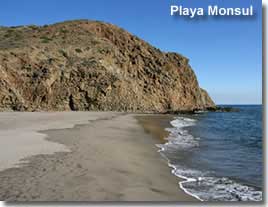 is one of the most visited of all the hidden coves of the Cabo de Gata, scenes from the Hollywood Blockbuster movie Indiana Jones and the Last Crusade, directed by Steven Spielberg and staring Harrison Ford have been filmed here. A miraculous landscape characterised by its volcanic dark sand, fossilised rock formations and sand dunes. A marvel of fish can be seen in the clear shallow waters inviting snorkelling enthusiasts to this wondrous setting.
is one of the most visited of all the hidden coves of the Cabo de Gata, scenes from the Hollywood Blockbuster movie Indiana Jones and the Last Crusade, directed by Steven Spielberg and staring Harrison Ford have been filmed here. A miraculous landscape characterised by its volcanic dark sand, fossilised rock formations and sand dunes. A marvel of fish can be seen in the clear shallow waters inviting snorkelling enthusiasts to this wondrous setting.
A path to the right of Monsul, accessible only on foot, leads to the cove of Cala de la Media Luna, a fine sandy beach in a bay the shape of a half moon.
San Jose to Las Negras
Cala de la Higuera
Access is from the road into, or out of, San Jose, heading towards the campsite, the beach is signposted and is reached along a track. This is a rocky beach but is notable as a snorkelling and diving destination.
The beaches of Escullos, Isleta del Moro and Rodalquilar.
The main beaches and coves between San Jose and the fishing village of Las Negras are signposted from the main ALP-826 road. 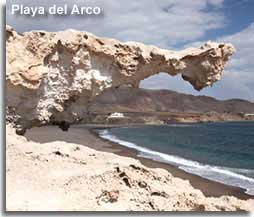
Playa del Arco and Cala de Embarcadero - Escullos.
With easy access the main beach area of Escullos is Playa del Arco, a wide sandy beach with some remarkable rock formations at one end, a favoured spot for taking shade 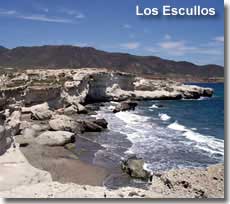 from the sun. The beach has its own car park and a couple of convenient eating establishments.
from the sun. The beach has its own car park and a couple of convenient eating establishments.
Los Escullos is defined by a raised area of fossilised dunes, where long term erosion from the sea has carved out impressive white cliffs. The 18th century defence castle, Castillo San Felipe, stands in prime position on top of the dunes, which can be walked across, with care.
Cala del Embarcadero is a small rural beach of sand and pebbles at the edge of Escullos.
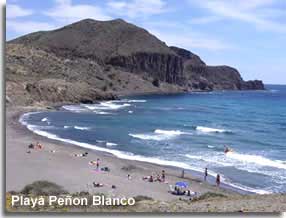
Playa del Peñon Blanco - Isleta del Moro
Playa del Peñon Blanco is the main beach for the small fishing village of Isleta del Moro, parking is available overlooking the bay just before entering the village. The beach is wide, sandy and fringed with an oasis of palm trees, it has fantastic views towards the off shore island from which Isleta del Moro is said to be named. The village has its own scuba diving centre where dives can be arranged to the many sites along the eastern coastline of the park, the centre is signposted through the village and situated with aspects towards the picturesque bay to the south of the island.
Water sports and water sports centres Cabo de Gata ![]()
Playa del Playazo - Rodalquilar
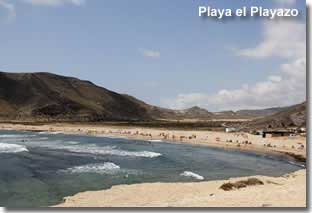
Situated in the lovely valley of Rodalquilar, the long and wide sandy beach is sheltered by hills on the one side and on the other by a rocky plinth which houses the Castillo de San Ramon 18th century castle, a defence stronghold, which, in times gone by, served to protect against the attacks and raids of pirates.
The waters are clear and shallow making this a particularly good beach for children.
The La Molata walking trail, which explores the coastline north of the Playazo, begins beside the San Ramon castle.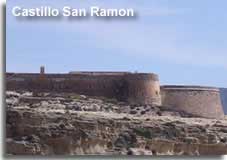
Walking trails of the Cabo de Gata ![]()
El Playazo is signposted from the main road via a track, which can easily be traversed by vehicle, though many choose to walk or cycle as the scenery is fabulous, the trail includes the ruins of the 16th century Torre de las Alumbres tower.
When I visited, I noticed that several families had driven their cars and vans and parked up close to the rocky area beside the beach and castle, there are no services here so many visitors had brought picnics, parasols and sun chairs, in fact all the necessities for a splendid day by the sea.
North from Agua Amarga
There are only two more beaches within the parks limits, the most northern being Playa el Algarrobico, a rural beach on the edge of the natural park to the north of Carboneras town. The border of Cabo de Gata extends around Carboneras therefore its beaches, with the exception of El Algarrobico, are not included within the boundaries of the natural park. 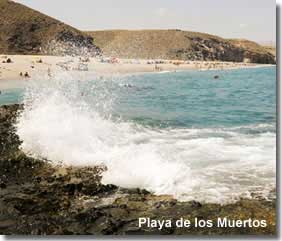
The Algarrobico beach is covered with the rest of the Carboneras beaches in the page dedicated to the beaches of the Levante.
This leaves Playa de los Muertos, detailed last but by no means least, this is the largest of the eastern shore beaches, in an incredible out of the way location between Agua Amarga and Carboneras.
Los Muertos beach
Recognised by its awesome rock features at the far right of the bay, the beach is made up of fine gravel and pebbles which serve to enhance the clearness of the aquamarine waters that lap the shore. For a beach that is so beautiful, its name oddly translates to the beach of the dead, 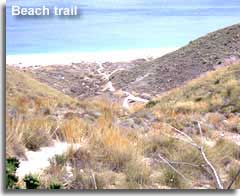 it relates to times of old when the bodies of dead sailors and pirates would be washed up by the currents. Best seen from the Los Muertos mirador, an observation point overlooking the beach, though best experienced in person, by taking either of the two walking trails that descend a distance of one kilometre down to the playa, it is not possible to access the trails by vehicle.
it relates to times of old when the bodies of dead sailors and pirates would be washed up by the currents. Best seen from the Los Muertos mirador, an observation point overlooking the beach, though best experienced in person, by taking either of the two walking trails that descend a distance of one kilometre down to the playa, it is not possible to access the trails by vehicle.
No problem going down to the beach, having already seen the destination enthusiasm to get there takes over, the climb back to the car park however is another matter, though it has to be said that this beach is well worth the effort.
The beach has its own information kiosk, with close access to the beach trails and the Muertos mirador, it can be located from the main ALP-712 from where it is signposted.
The following 2 photos, and the observations, were sent to me from Lorna Brewster after Lorna and her family visited Playa de los Muertos in July 2015, 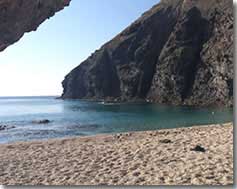 I had the absolute pleasure of meeting Lorna, the lovely Georgia, Chris and Lorna's parents while they were holidaying here.
I had the absolute pleasure of meeting Lorna, the lovely Georgia, Chris and Lorna's parents while they were holidaying here.

Lorna: " I think it's possibly the nicest place I've snorkelled so far as the big pebbles make it a lovely beach to sunbathe on and the water is so clear, even down to the seabed, as there's no sand to murky the waters, not sure you'll want to add the photo with Chris on, lol, but it does show how gorgeous the water is for snorkelling. "
Thank you Lorna and Chris, as you can see I did add the one of Chris, yep you were right, it shows the clarity of the water beautifully, Chris looks like he is having a great time too, thank you to you both for sharing, hope to see you all back here again soon.
Cabo de Gata, Almeria... a premier choice of quality beaches all in one natural park... unspoilt, idyllic, deserted, family friendly...
Beach services in Cabo de Gata
Remember, apart from the resort beaches, most of these natural beaches, particularly on the eastern coastline, are in out of the way locations which have no services and can sometimes only be reached on foot, thus providing a true paradise and place to escape from it all.
Water sports in Cabo de Gata
Not surprisingly Cabo de Gata is one of Almerias most popular destinations for water sports.
Water sports and water sports centres Cabo de Gata ![]()
Naturism in Cabo de Gata
Naturism is practised on many of the beaches of Cabo de Gata, mainly the beaches on the eastern coastline except for the main resort towns, while many people choose to wear bathing suits, it is perfectly acceptable to be naked.
A list of the naturist beach is provided from the Introduction to the Beaches of Almeria.
The Beaches of Almeria
An introduction to the Beaches of Almeria ![]()
including accessibility guide - naturist beaches - map of Almeria coastline
The Levante Beaches of Almeria ![]()
The Poniente Beaches of Almeria ![]()




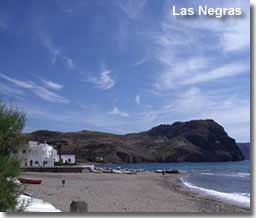 The walking trail San Pedro - El Plomo - Agua Amarga offers access to the beaches, the route is over eleven kilometres long and of medium to high difficulty.
The walking trail San Pedro - El Plomo - Agua Amarga offers access to the beaches, the route is over eleven kilometres long and of medium to high difficulty.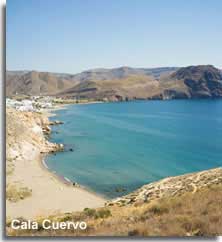 A small promenade links the beach to the village centre with the convenience of its cafes, bars, shops and restaurants close at hand. Parking is available in the pretty streets behind the promenade. The water sports centre offers, scuba diving, kayaks, boat hire and boat trips, along with guided trekking and mountain bike hire. Las Negras is a relaxing destination, and for those seeking adventure a perfect base to explore the countryside and the secluded coves to the north.
A small promenade links the beach to the village centre with the convenience of its cafes, bars, shops and restaurants close at hand. Parking is available in the pretty streets behind the promenade. The water sports centre offers, scuba diving, kayaks, boat hire and boat trips, along with guided trekking and mountain bike hire. Las Negras is a relaxing destination, and for those seeking adventure a perfect base to explore the countryside and the secluded coves to the north.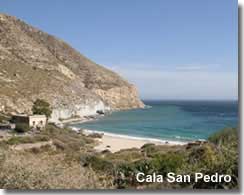 river bed, it can be reach by vehicle, cycle or on foot along a cliff track which is signposted from the road descending to Negras village.
river bed, it can be reach by vehicle, cycle or on foot along a cliff track which is signposted from the road descending to Negras village.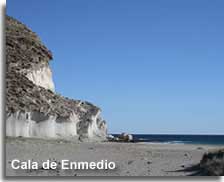 This beach is classified as a naturist beach, where swim wear is optional.
This beach is classified as a naturist beach, where swim wear is optional.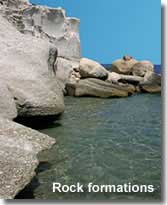 del Plomo is almost central between the two villages. Both beaches are lapped by the crystal clear turquoise sea, Cala de Enmedio is a beach of fine white sand, and Cala del Plomo is both sand and stones, as with Cala de San Pedro, both of these are nudist beaches. This section of the coastline is characterised by the breathtaking vision of its unique white cliffs and is well noted for its unusual volcanic rock formations, shaped over time by
del Plomo is almost central between the two villages. Both beaches are lapped by the crystal clear turquoise sea, Cala de Enmedio is a beach of fine white sand, and Cala del Plomo is both sand and stones, as with Cala de San Pedro, both of these are nudist beaches. This section of the coastline is characterised by the breathtaking vision of its unique white cliffs and is well noted for its unusual volcanic rock formations, shaped over time by 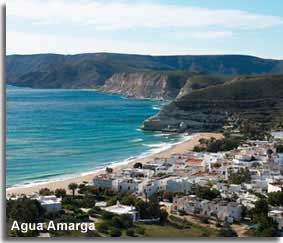 the actions of the sea, huge boulders and smooth rock platforms line the waters edge.
the actions of the sea, huge boulders and smooth rock platforms line the waters edge.


